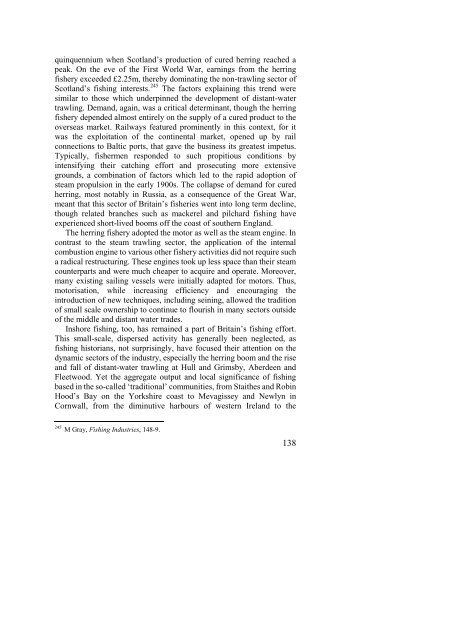The North Atlantic Fisheries, 1100-1976 - University of Hull
The North Atlantic Fisheries, 1100-1976 - University of Hull
The North Atlantic Fisheries, 1100-1976 - University of Hull
Create successful ePaper yourself
Turn your PDF publications into a flip-book with our unique Google optimized e-Paper software.
quinquennium when Scotland’s production <strong>of</strong> cured herring reached a<br />
peak. On the eve <strong>of</strong> the First World War, earnings from the herring<br />
fishery exceeded £2.25m, thereby dominating the non-trawling sector <strong>of</strong><br />
Scotland’s fishing interests. 245 <strong>The</strong> factors explaining this trend were<br />
similar to those which underpinned the development <strong>of</strong> distant-water<br />
trawling. Demand, again, was a critical determinant, though the herring<br />
fishery depended almost entirely on the supply <strong>of</strong> a cured product to the<br />
overseas market. Railways featured prominently in this context, for it<br />
was the exploitation <strong>of</strong> the continental market, opened up by rail<br />
connections to Baltic ports, that gave the business its greatest impetus.<br />
Typically, fishermen responded to such propitious conditions by<br />
intensifying their catching effort and prosecuting more extensive<br />
grounds, a combination <strong>of</strong> factors which led to the rapid adoption <strong>of</strong><br />
steam propulsion in the early 1900s. <strong>The</strong> collapse <strong>of</strong> demand for cured<br />
herring, most notably in Russia, as a consequence <strong>of</strong> the Great War,<br />
meant that this sector <strong>of</strong> Britain’s fisheries went into long term decline,<br />
though related branches such as mackerel and pilchard fishing have<br />
experienced short-lived booms <strong>of</strong>f the coast <strong>of</strong> southern England.<br />
<strong>The</strong> herring fishery adopted the motor as well as the steam engine. In<br />
contrast to the steam trawling sector, the application <strong>of</strong> the internal<br />
combustion engine to various other fishery activities did not require such<br />
a radical restructuring. <strong>The</strong>se engines took up less space than their steam<br />
counterparts and were much cheaper to acquire and operate. Moreover,<br />
many existing sailing vessels were initially adapted for motors. Thus,<br />
motorisation, while increasing efficiency and encouraging the<br />
introduction <strong>of</strong> new techniques, including seining, allowed the tradition<br />
<strong>of</strong> small scale ownership to continue to flourish in many sectors outside<br />
<strong>of</strong> the middle and distant water trades.<br />
Inshore fishing, too, has remained a part <strong>of</strong> Britain’s fishing effort.<br />
This small-scale, dispersed activity has generally been neglected, as<br />
fishing historians, not surprisingly, have focused their attention on the<br />
dynamic sectors <strong>of</strong> the industry, especially the herring boom and the rise<br />
and fall <strong>of</strong> distant-water trawling at <strong>Hull</strong> and Grimsby, Aberdeen and<br />
Fleetwood. Yet the aggregate output and local significance <strong>of</strong> fishing<br />
based in the so-called ‘traditional’ communities, from Staithes and Robin<br />
Hood’s Bay on the Yorkshire coast to Mevagissey and Newlyn in<br />
Cornwall, from the diminutive harbours <strong>of</strong> western Ireland to the<br />
245 M Gray, Fishing Industries, 148-9.<br />
138















